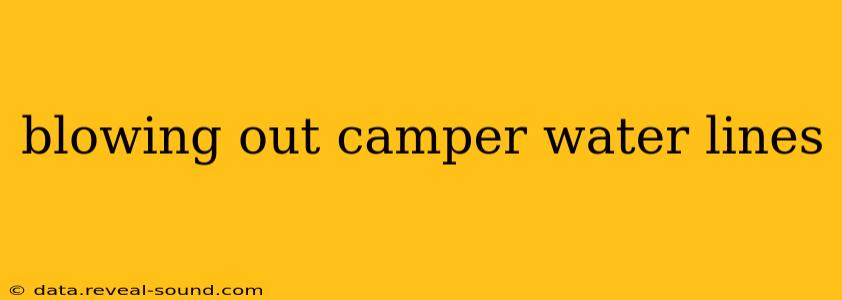Winterizing your RV is crucial to prevent costly damage from freezing water lines. One of the most important steps is thoroughly blowing out your camper's water lines. This process removes all remaining water, preventing expansion and potential pipe bursts when temperatures drop below freezing. This comprehensive guide will walk you through the process, addressing common questions and concerns.
Why is Blowing Out Camper Water Lines Important?
Freezing water expands, and this expansion can exert immense pressure on your RV's plumbing system. This pressure can cause pipes to crack or burst, leading to expensive repairs, water damage, and potentially ruining your RV's interior. Blowing out the lines removes the water, eliminating this risk entirely. It's a preventative measure that safeguards your investment.
What Equipment Do I Need to Blow Out My Camper Water Lines?
You'll need a few essential tools for this job:
- Air Compressor: A portable air compressor is ideal. Choose one with sufficient pressure (at least 30 PSI) and a regulator to control the air pressure.
- Air Chuck: This connects the air compressor to your water system.
- Blow Gun: A blow gun helps direct the compressed air effectively. You'll need to adapt it to fit your water system's fittings (usually a standard garden hose fitting).
- Water Hose: This will help you drain out as much water as possible before you use the air compressor.
- RV Antifreeze (Optional): While blowing out the lines is the primary method, adding RV antifreeze provides an extra layer of protection.
How to Blow Out Camper Water Lines: A Step-by-Step Guide
-
Drain All Water: Begin by draining all water from your RV's tanks, hot water heater, and low-point drains. Open all faucets and let them run until no more water comes out. This is essential for maximizing efficiency with the compressor.
-
Connect the Air Compressor: Attach the air chuck to the lowest point of your water system. This is usually located near a low-point drain. If you have a low point drain, use the blow gun or connect it to that valve.
-
Turn On the Air Compressor: Slowly increase the air pressure to 30 PSI (or the maximum your system can handle) and monitor the process. Ensure that the air is evenly distributed throughout your system.
-
Open Faucets: Open each faucet, one by one, starting with the ones furthest from the compressor. This helps ensure all water is expelled from the entire system. Keep them open while you are blowing out the lines.
-
Check for Leaks: Once you’ve blown out all the water, carefully check all connections and faucets for any leaks.
-
Add RV Antifreeze (Optional): For added protection, you can add RV antifreeze to your system after blowing out the lines. This will prevent any remaining moisture from freezing.
What if I Don't Have an Air Compressor?
If you don't own an air compressor, you can use compressed air cans, but this is far less effective for larger RVs and may require many cans. This method is best for smaller systems and can be a supplement to other methods.
How Do I Blow Out the Water Lines in My Water Heater?
Your water heater needs special attention. Consult your water heater's manual for specific instructions, but the general principle is the same: drain it completely and then use compressed air to remove any remaining water. Many water heaters have a drain valve to assist with this process.
Can I Use a Shop Vacuum in Reverse to Blow Out Water Lines?
While theoretically possible, using a shop vacuum in reverse is not recommended. Shop vacs aren't designed for this high-pressure application, and you risk damaging the vacuum. An air compressor is the safest and most effective tool for this task.
What are the Signs of Frozen Water Lines in My Camper?
If you suspect your water lines have frozen, look for these signs:
- No water pressure: The most obvious sign.
- Bulging or cracked pipes: Inspect your visible plumbing.
- Water leaks: Check for leaks around faucets or connections.
Maintaining Your RV's Water System
Regular maintenance is key to preventing issues. Before winterizing, it’s helpful to flush your water system to remove sediment and debris which might interfere with the proper draining and blowing out of the system. This can increase the efficiency of the process.
By following these steps and addressing the common concerns discussed, you can effectively blow out your camper's water lines and protect your RV from freeze damage during the colder months. Remember, preventative measures are far less expensive than repairs!
